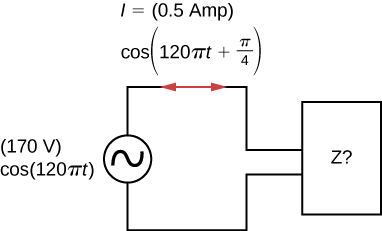| << Chapter < Page | Chapter >> Page > |

We then find for the bandwidth
Check Your Understanding In the circuit of [link] , and (a) What is the resonant frequency? (b) What is the impedance of the circuit at resonance? (c) If the voltage amplitude is 10 V, what is i ( t ) at resonance? (d) The frequency of the AC generator is now changed to 200 Hz. Calculate the phase difference between the current and the emf of the generator.
a. 160 Hz; b. ; c. ; d. 0.023 rad
Check Your Understanding What happens to the resonant frequency of an RLC series circuit when the following quantities are increased by a factor of 4: (a) the capacitance, (b) the self-inductance, and (c) the resistance?
a. halved; b. halved; c. same
Check Your Understanding The resonant angular frequency of an RLC series circuit is An ac source operating at this frequency transfers an average power of to the circuit. The resistance of the circuit is Write an expression for the emf of the source.
(a) Calculate the resonant angular frequency of an RLC series circuit for which , , and (b) If R is changed to what happens to the resonant angular frequency?
The resonant frequency of an RLC series circuit is If the self-inductance in the circuit is 5.0 mH, what is the capacitance in the circuit?
(a) What is the resonant frequency of an RLC series circuit with , , and ? (b) What is the impedance of the circuit at resonance?
For an RLC series circuit, , , and (a) If an ac source of variable frequency is connected to the circuit, at what frequency is maximum power dissipated in the resistor? (b) What is the quality factor of the circuit?
a. 820 Hz; b. 7.8
An ac source of voltage amplitude 100 V and variable frequency f drives an RLC series circuit with , , and (a) Plot the current through the resistor as a function of the frequency f . (b) Use the plot to determine the resonant frequency of the circuit.
(a) What is the resonant frequency of a resistor, capacitor, and inductor connected in series if , and ? (b) If this combination is connected to a 100-V source operating at the constant frequency, what is the power output of the source? (c) What is the Q of the circuit? (d) What is the bandwidth of the circuit?
a. 50 Hz; b. 50 W; c. 13; d. 25 rad/s
Suppose a coil has a self-inductance of 20.0 H and a resistance of . What (a) capacitance and (b) resistance must be connected in series with the coil to produce a circuit that has a resonant frequency of 100 Hz and a Q of 10?
An ac generator is connected to a device whose internal circuits are not known. We only know current and voltage outside the device, as shown below. Based on the information given, what can you infer about the electrical nature of the device and its power usage?

The reactance of the capacitor is larger than the reactance of the inductor because the current leads the voltage. The power usage is 30 W.

Notification Switch
Would you like to follow the 'University physics volume 2' conversation and receive update notifications?